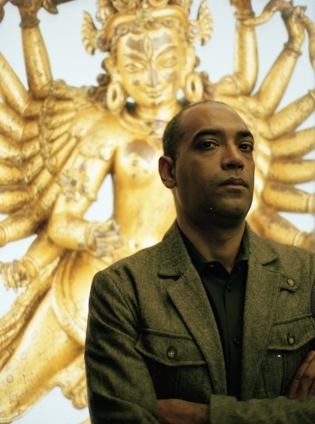In The Beautiful and the Damned, journalist and novelist Siddhartha Deb attempts what
might seem impossible at first -- to create, through the stories of a few
Indians interviewed over a span of a few years, a portrait of the new India.
His ambition is vast: to include "the urban and the rural; the rich, the
middle class and the poor; men and women; the technology driven work that is
seen as symptomatic of the new India as well as the exhausting manual labor
that is considered irrelevant." In a chapter about migrant factory workers
in a steel company in Andhra Pradesh, Deb writes, "And yet, from the
tongsman to the guards, each worker had only a fragmentary, partial picture of
the factory, a cog's perspective of a large wheel. When I put these different
fragments together, I got not a whole but a bewildering, cubist image."
That can be said about this book as well. The portrait of India that emerges is
fragmentary, disjointed, and symbolic -- but ultimately, like a successful
piece of cubist art, complex, engrossing, and thought-provoking.
For the book, Deb draws both on
his own past experiences living and working in India, and on research and
interviews with his varied subjects. Brought up in Shillong in North-East
India, Deb worked in Calcutta teaching spoken English to students in a computer
programming institute, and with a newspaper in Delhi, before moving to the
United States, where he now teaches creative writing. One of his novels, The Point of Return,
was a 2003 New York Times Notable Book of the Year. His journalistic work
includes an article for the Guardian, UK, that required an undercover stint as
a call center worker in India.
The Beautiful and the Damned concentrates on five scenarios: the glitzy, dubious world
of a fast-talking, self-promoting, entrepreneur millionaire; the insular world
of people working in the IT industry, looking to America for professional and
personal models; the suicide-riddled world of farmers and activists struggling
as small-time agriculture loses its viability; the bleak world of migrant
workers packed into slums and pressed into hard labor in factories in
burgeoning special economic zones; and the illusory world of young women in
service jobs in big cities lured by the promise of economic and personal
freedom. This is not a book that portrays the new India in a rosy light -- not
even a book that attempts balance between success stories and failure. Instead
it seeks to highlight the hidden price of success and the unreported toll of
failure. In that sense then, this is only a partial portrait: the darker,
uglier, frequently ignored part, the part that many partaking of the success
would rather not acknowledge. This is clearly Deb’s intention, and he admits to
having chosen these angles deliberately.

Photo of the author by Rafil Kroll-Zaidi
His endeavor therefore rests on
how well these stories of specific situations and individuals generalize to the
wider “new India.” The most successful of the stories deal with destitute
farmers in a chapter called “Red Sorghum: Farmers in the Free Market,” and
migrant workers in “The Factory: The Permanent World of Temporary Workers.” In
both these chapters, Deb’s research, supported by statistics and numbers,
coupled with his empathetic novelistic eye, make for compelling, if harrowing,
reading. “Red Sorghum,” especially, reads like a thriller, as Deb investigates
a failed deal to bring a harvest’s worth of sorghum to the market. The
unexpected conclusion of this chapter, which reveals one of the prime movers in
the deal as himself a victim of the savage competitive practices of his
adversaries, underlines the reality that it’s money that begets money. Those
without are doomed to penury and suicide.
A similar situation
faces the migrant workers. Deb describes their daily routine, living in
slum-like barracks, with a steely-eyed absence of romanticization: “There was
no hint of domesticity about the food being prepared, nor any sign of pleasure.
They chopped vegetables mechanically, smoked a cigarette or beedi, and urinated
into the gutter.” These are people with no present and no future. They have no
one looking out for them, not even the government officials tasked with
enforcing regulations like payments for health insurance and pensions. “When
the government officials showed up at a factory and discovered these
violations, they did not enforce the rules. Instead, they took a cash bribe,
got back into their vehicles, and drove back down their highway, so that the
lack of future for many of the workers was converted into the present
enrichment of officials and factory owners.” Deb’s despair breaks through in
these chapters. He offers a vision of a young man, in his teens, walking down
the middle of the road, stumbling, drunk: “there was something about him that
suggested a terrible violation, as if he had been raped and set loose in the
street.” These are powerful chapters, and by themselves worth the price of the
book.
The other stories were
undermined to various degrees by an adversarial tone that Deb adopts with his
more successful subjects, as though their very success made empathy towards
them unnecessary. The portrait Deb paints of millionaire entrepreneur Arindam
Chaudhari, whom he anoints “The Great Gatsby” for his lavish lifestyle and
reputation as a fraud and scamster, is definitely not flattering, even if
justified. The epithet may not fit, since Fitzgerald’s Gatsby is both a
sympathetic and pathetic character, while Deb’s Chaudhari comes across as only
the latter. Meeting an engineer poet in Bangalore, who writes incomprehensible
binary poems etched in microchips, Deb stumps him by asking his opinion on
economic inequality and climate change. And though Deb’s empathy clearly
extends to Esther, a young waitress working in an upscale restaurant in Delhi,
I was left with the impression that his interest in her stemmed from her
self-deception, from her initial assertion that she was living the life she
wanted.
What holds the book
together despite its fragmentary and episodic nature is Deb’s writing. The
prose effortlessly mixes facts and impressions and history and descriptions.
Places and characters come alive as Deb wields a novelistic pen. And there is
such a deep unquestionable humanity to Deb’s investigation of those left
behind, that the book continues to thrust itself into my consciousness as I
look around myself in India, where I’m writing this review.
***
Nawaaz Ahmed is a transplant from Tamil Nadu, India. He holds a Ph.D. in Computer Science from Cornell University, and an MFA in Creative Writing from the University of Michigan, Ann Arbor, where he won Hopwood awards for his short stories, non-fiction, and his novel-in-progress.









Comments